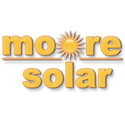How Solar Works
Photovoltaic technology is a simple and elegant solution that is virtually maintenance free. It has no moving parts! Its energy source, sunlight, is reliable, locally available, and always free.
But how does it all work? Watch this short video for a great demonstration for how solar works!
The solar panels capture the solar energy and convert it into direct electrical current. This takes place throughout the day when sun is visible (including cloudy days).
A component called the inverter then transforms this direct current into alternate current and powers your house's main electrical panel. Any excess energy not used by your home is fed back to the utility grid.
This process is commonly referred to as "net metering." Net metering means that when your solar panels are producing lots of electricity, but you're not using it (say, you're gone during a summer day and no lights or air conditioners are turned on), the electricity flows out of your meter and into the grid and becomes part of the utility's available power.
In essence, you can think of the grid as a giant battery storage: any excess power produced during the day is sold to the power company and purchased back at night when your panels are not producing).
This is the reason why, in most grid-tied solar systems, there is no battery storage. Although it can be installed, battery storage adds quite a bit of installation and maintenance cost and it simply isn't necessary since the utility company acts as your "battery."
